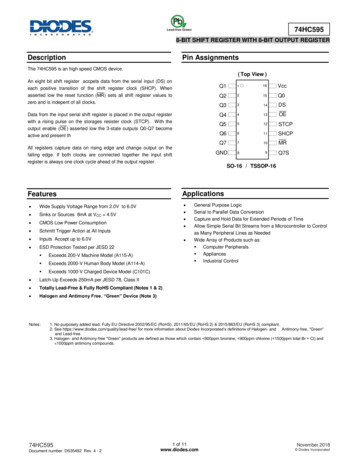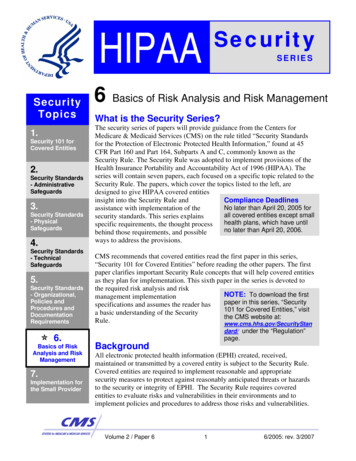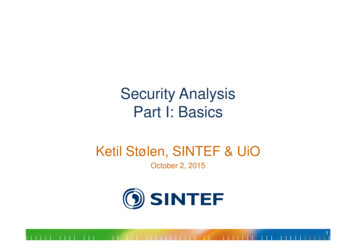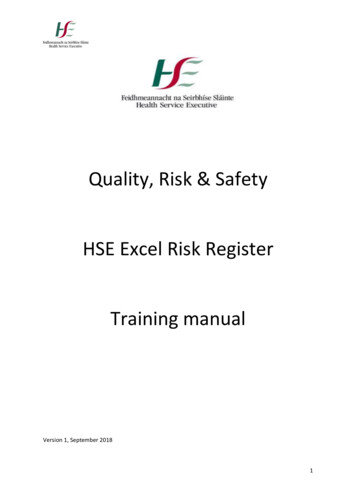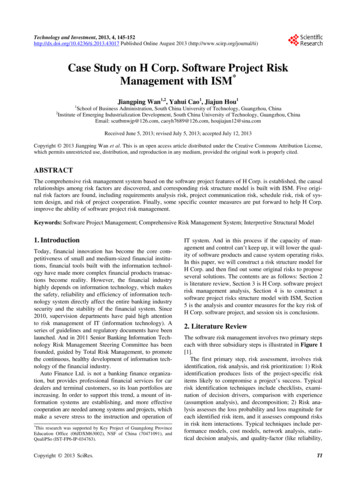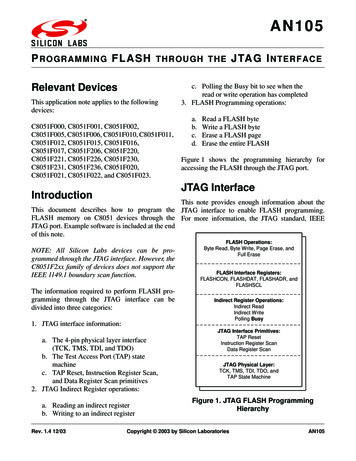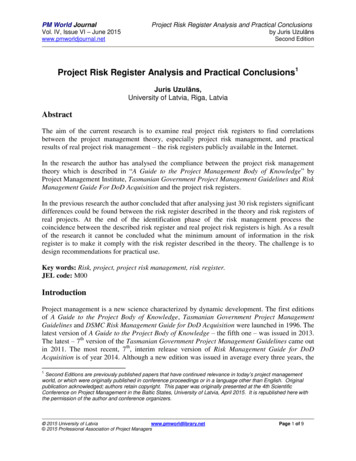
Transcription
PM World JournalVol. IV, Issue VI – June 2015Project Risk Register Analysis and Practical Conclusionsby Juris Uzulānswww.pmworldjournal.netSecond EditionProject Risk Register Analysis and Practical Conclusions 1Juris Uzulāns,University of Latvia, Riga, LatviaAbstractThe aim of the current research is to examine real project risk registers to find correlationsbetween the project management theory, especially project risk management, and practicalresults of real project risk management – the risk registers publicly available in the Internet.In the research the author has analysed the compliance between the project risk managementtheory which is described in “A Guide to the Project Management Body of Knowledge” byProject Management Institute, Tasmanian Government Project Management Guidelines and RiskManagement Guide For DoD Acquisition and the project risk registers.In the previous research the author concluded that after analysing just 30 risk registers significantdifferences could be found between the risk register described in the theory and risk registers ofreal projects. At the end of the identification phase of the risk management process thecoincidence between the described risk register and real project risk registers is high. As a resultof the research it cannot be concluded what the minimum amount of information in the riskregister is to make it comply with the risk register described in the theory. The challenge is todesign recommendations for practical use.Key words: Risk, project, project risk management, risk register.JEL code: M00IntroductionProject management is a new science characterized by dynamic development. The first editionsof A Guide to the Project Body of Knowledge, Tasmanian Government Project ManagementGuidelines and DSMC Risk Management Guide for DoD Acquisition were launched in 1996. Thelatest version of A Guide to the Project Body of Knowledge – the fifth one – was issued in 2013.The latest – 7th version of the Tasmanian Government Project Management Guidelines came outin 2011. The most recent, 7th, interim release version of Risk Management Guide for DoDAcquisition is of year 2014. Although a new edition was issued in average every three years, the1Second Editions are previously published papers that have continued relevance in today’s project managementworld, or which were originally published in conference proceedings or in a language other than English. Originalpublication acknowledged; authors retain copyright. This paper was originally presented at the 4th ScientificConference on Project Management in the Baltic States, University of Latvia, April 2015. It is republished here withthe permission of the author and conference organizers. 2015 University of Latviawww.pmworldlibrary.net 2015 Professional Association of Project ManagersPage 1 of 9
PM World JournalVol. IV, Issue VI – June 2015Project Risk Register Analysis and Practical Conclusionsby Juris Uzulānswww.pmworldjournal.netSecond Editionauthor considers that none of them contains references to research results; it can be assumed thatthe manuals represent theoretical reflection on the authors’ experience. However, thedevelopment of a science is impossible without research and research-based conclusions andrecommendations.The article describes the research on 30 risk registers. The aim of the study is to assess thecompliance of the publicly (in the Internet) available project risk registers with the description ofproject risk management in three project risk management manuals. For the purposes of theresearch the author has used both quantitative and qualitative research methods.ResearchAccording to the 2013 issue of A Guide to the Project Management Body of Knowledge orPMBoK 2013, the risk register is a kind of project documents. (A Guide to the Project , 2013).The risk register is used in five out of six subprocesses of Project Time Management, ProjectCost Management, Project Quality Management and Project Risk Management (A Guide to theProject , 2013). In PMBoK the risk register is defined as a document in which the results ofrisk analysis and risk response planning are recorded (A Guide to the Project , 2013). PMBoKis not an example of a risk register document. The components of the risk register are describedin accordance with the subprocesses of Project Risk Management.In the “Identify”, or the second, subprocess the primary output from the “Identify Risks” is theinitial entry into the risk register, where the risk register includes the list of identified risks andlist of potential responses (A Guide to the Project , 2013). As the term “list” is used andassuming that the list of identified risks and list of potential responses have been co-ordinated, itcan be concluded that at the end of the “Identify” sub process the risk register represents a tablewith two columns.In the “Perform qualitative risk analysis” sub process the risk register is supplemented with theassessments of probability and impacts for each risk, risk ranking or scores, risk urgencyinformation or risk categorization and a watch list for low probability risks or risks requiringfurther analysis (A Guide to the Project , 2013). In the 2013 issue of PMBoK there isinsufficient information for judging how the watch list for low probability risks or risks requiringfurther analysis is included in the risk register – as an individual column or separate table.In the “Perform quantitative risk analysis” sub process the risk register updates could include theprobabilistic analysis of the project, probability of achieving cost and time objectives, prioritizedlist of quantified risks, trends in quantitative risk analysis results. Like in the “Performqualitative risk analysis” sub process, the 2013 issue of PMBoK does not contain sufficientinformation for concluding how the information on registered analysis is included in the riskregister – as individual columns or a separate table, or whether the information is included in therisk register at all because the phrase “could include” is used. 2015 University of Latviawww.pmworldlibrary.net 2015 Professional Association of Project ManagersPage 2 of 9
PM World JournalVol. IV, Issue VI – June 2015Project Risk Register Analysis and Practical Conclusionsby Juris Uzulānswww.pmworldjournal.netSecond EditionIn the “Plan risk responses” sub process the content of the risk register becomes still less certainas before listing the risk register components it is said that “updates to the risk register caninclude, but are not limited to” (A Guide to the Project , 2013). Table 1 lists the possiblecolumns or separate tables of the risk register.In the “Control risks” sub process the risk register is not supplemented.Table 1.Risk register according to PMBoK 2013 project risk management sub processesSub e RiskAnalysisPerformQuantitative RiskAnalysisPlanResponsesRiskInformation in the risk register by sub processList of identified risksList of potential responsesList of identified risksList of potential responsesAssessments of probabilityAssessments of impactsRisk ranking or scoresRisk categorizationWatch list for low probability risks or risks requiring furtheranalysisProbabilistic analysis of the projectProbability of achieving cost and time objectivesPrioritized list of quantified risksTrends in quantitative risk analysis resultsRisk owners and assigned responsibilitiesAgreed-upon response strategiesSpecific actions to implement the chosen response strategyTrigger conditions, symptoms, and warning signs of a riskoccurrenceBudget and schedule activities required to implement thechosen responsesContingency plans and triggers that call for their executionFall-back plans for use as a reaction to a risk that hasoccurred and the primary response proves to be inadequateResidual risks that are expected to remain after plannedresponses have been taken, as well as those that have beendeliberately acceptedSecondary risks that arise as a direct outcome of 2015 University of Latviawww.pmworldlibrary.net 2015 Professional Association of Project ManagersNotesNo risk registerThe risk register can be made asa table with 2 columnsNo unanimous conclusion canbe made whether the watch listfor low probability risks or risksrequiring further analysis is aseparate table or just a row inthe risk register which wascreated during the “Identify”sub process.No unanimous conclusion canbemadewhethertheprobabilistic analysis of theproject, probability of achievingcost and time objectives,prioritized list of quantifiedrisks, trends in quantitative riskanalysis results are a separatetable or individual columns inthe risk register which wascreated during the “Identify”sub process or they are projectdocuments of some other kindor their components.No unanimous conclusion canbe made whether the results ofthe “Plan risk response” areseparate tables or individualcolumns in the risk register wascreated during the “Identify”sub process or they are projectdocuments of some other kindor their components.Page 3 of 9
PM World JournalVol. IV, Issue VI – June 2015Project Risk Register Analysis and Practical Conclusionsby Juris Uzulānswww.pmworldjournal.netSecond Editionimplementing a risk responseContingency reserves that are calculated based on thequantitative risk analysis of the project and theorganization’s risk thresholdsControl RisksThe structure of the risk registeris not changed; the content ofthe risk register is supplementedor changed.Source: Author constructionIt can be concluded that the risk register of A Guide to the Project Management Body ofKnowledge cannot be created as a project management document, disregarding the number oftables or number of columns in a table as the phrases “can include” or “can include, but are notlimited” are used and there is insufficient description of the results of the risk management subprocesses and the method of integrating them in the risk register or other project documents ortheir components.The risk register of DoD Risk Management Guide for Defence Acquisition Programs, 7th Edition(Interim Release) is a table with 15 columns – Risk number, Linked WBS/IMS ID#, Owner,Type of risk, Status, Tier, Risk event, Likelihood/Consequence rating, Risk reporting matrix,Risk mitigation strategy, Submitted date, Board review, Planned closure, Expected risk rating,and Plan status (DoD Risk Management Guide , 2014).The risk register of the Tasmanian Government Project Management Guidelines, version 7.0 is atable with 13 columns – Unique identifier for each risk, Description of each risk, Impact onproject, Assessment of the likelihood, Assessment of the seriousness, Risk grade, Change (aboutany change in the risk grading), Date of review, Mitigation actions, Responsibility, Cost,Timeline, and Work breakdown structure (Tasmanian Government Project , 2011).We can conclude that DoD Risk Management Guide for Defence Acquisition Programs unTasmanian Government Project Management Guidelines are more unanimous sources for riskassessment as they describe the form of the risk register table and define the contents, or thenumber of columns, of the risk register.Table 2 provides the comparison of the risk register columns of DoD Risk Management Guidefor Defence Acquisition Programs and Tasmanian Government Project Management Guidelines. 2015 University of Latviawww.pmworldlibrary.net 2015 Professional Association of Project ManagersPage 4 of 9
PM World JournalVol. IV, Issue VI – June 2015Project Risk Register Analysis and Practical Conclusionsby Juris Uzulānswww.pmworldjournal.netSecond EditionTable 2Comparison of the Risk Register Columns of DoD Risk Management Guide for DefenceAcquisition Programs and Tasmanian Government Project Management GuidelinesHeading of the risk register column inDoD Risk Management Guide forDefence Acquisition ProgramsRisk numberLinked WBS/IMS ID#Heading of the risk registercolumn in the TasmanianGovernment ProjectManagement GuidelinesUnique identifier for each riskWork breakdown structureOwnerType of riskStatusTierRisk eventDescription of each riskLikelihood/ Consequence ratingRisk reporting matrixRisk mitigation strategySubmitted dateBoard reviewPlanned closureExpected risk ratingAssessment of the likelihoodAssessment of the seriousnessNotesThe location of the columns in thetables does not coincideThere are absolutely no coincidencesin the column contents as the sourcesdiffer in their treatment of the riskmanagement theoryThe number of the columns does notcoincideMitigation actionsDate of reviewRisk gradeThe location of the columns in thetable does not coincidePlan statusResponsibilityImpact on projectCostTimelineSource: Author constructionResearch results and discussionThe research comprised analysis of 30 risk registers. The selection of the registers was made inNovember, 2013 with the Google search engine by requesting “project risk register” and the first10 web pages with the search results were examined. Taking into account that the aim of theresearch was not to find regularities in the risk registers, no assessment was made concerning thegeneral set of risk registers and the kind of the selection. The author believes that 30 riskregisters constitute a sufficient number for comparing the selected registers with the risk registerdescribed in A Guide to the Project Management Body of Knowledge or PMBoK 2013ed., DoDRisk Management Guide for Defense Acquisition Programs, 7th Edition (Interim Release), andTasmanian Government Project Management Guidelines, version 7.0. (J.Uzulans, 2014). 2015 University of Latviawww.pmworldlibrary.net 2015 Professional Association of Project ManagersPage 5 of 9
PM World JournalVol. IV, Issue VI – June 2015Project Risk Register Analysis and Practical Conclusionsby Juris Uzulānswww.pmworldjournal.netSecond EditionIn the previous research the risk registers were described and it was concluded that by analysingjust 30 risk registers significant differences can be found between the risk register described in AGuide to the Project Management Body of Knowledge and risk registers of real projects. At theend of the identification phase of the risk management process the coincidence between thedescribed risk register and real project risk registers is high, in all registers the followinginformation indicated in all PMBoK editions, except year 2013 one, is present – the name of therisk, risk description, consequences and risk owner. However, this information is not present inall risk registers (see table 3). The coincidence can be considered high only by examining thewhole set of the risk registers under the study as there are significant individual differencesamong the risk registers (J.Uzulans, 2014).In the case of DoD Risk Management Guide for Defense Acquisition Programs, 7th Edition(Interim Release), and Tasmanian Government Project Management Guidelines, version 7.0 theassessment of the risk register coincidence is easier. Firstly, how many risk registers out of 30 donot comply if the number of columns is smaller than 13. 2 registers have up to 5 columns, 14registers have between 7 and 12 columns, 10 registers have between 14 and 19 columns and 4registers have more than 20 columns. No risk register has exactly 13 columns, 1 register has 15columns. 6 risk registers have 15 or more columns, 14 risk registers have more than 13 columns.Table 3Comparison of the Risk Register Columns in DoD Risk Management Guide for DefenseAcquisition Programs and Tasmanian Government Project Management Guidelines and inRisk RegistersRisk Register of DoD RiskCoincidenceRisk Register of Tasmanian CoincidenceManagement Guide forof the contentsGovernment Projectof the contentsDefense Acquisition Programs of risk registerManagement Guidelinesof riskcolumnsregistercolumnsRisk number6Unique identifier for each13riskLinked WBS/IMS ID#0Work breakdown structure0Owner4Type of risk1Status4Tier0Risk event4Description of each risk10Likelihood/ Consequence rating6Assessment of the likelihood14AssessmentoftheseriousnessRisk reporting matrix0Risk mitigation strategy6Mitigation actions13Submitted date1Board review1Date of review1 2015 University of Latviawww.pmworldlibrary.net 2015 Professional Association of Project ManagersPage 6 of 9
PM World JournalVol. IV, Issue VI – June 2015Project Risk Register Analysis and Practical Conclusionsby Juris Uzulānswww.pmworldjournal.netPlanned closureExpected risk ratingPlan statusSecond Edition050Risk grade13ResponsibilityImpact on projectCostTimeline3002Source: Author constructionConclusions, proposals, recommendationsThe research has not provided the answer on what an accurate risk register is. From the data inTable 3 we can conclude that several columns can be considered essential in the risk register.They are as follows: Risk number, Risk description, Risk likelihood, Risk consequence, and Riskmitigation. According to the risk register definition no risk register can be made without the Riskdescriptions column. Without the columns of Risk likelihood, Risk consequence and Risk rating,however, project risk management cannot be effective as there are no criteria on how to managerisks or what actions and when are necessary.The risk registers are different and the coincidence or difference of column headings does notguarantee that the column contents will be the same or, respectively, different. The analysis ofthe risk registers solely by column headings is insufficient – a more profound quantitativeanalysis of the risk registers must be performed by finding the appropriate project managementor project risk management theory description for each of the risk registers used in the research.However, it is not guaranteed that such an analysis will be sufficient. Certainly, a bigger numberof risk registers could be analysed than it has been done in the research and then arrive to theconclusion that the more common columns are more accurate than the less common ones. Thiskind of research results might also be insufficient for drawing conclusions. The effectiveness ofproject risk management and the risk register as one of the components of effective riskmanagement could be one of the criteria of the risk register accuracy. However, the theory ofproject management effectiveness has neither been fully designed. The research on risk registerscould promote and facilitate the research on the effectiveness of project management.BibliographyA Guide to the Project Management Body of Knowledge. (PMBOK Guide) – Fifth Edition, Project ManagementInstitute, 2013, p. 589.DoD Risk Management Guide for Defence Acquisition Programs, 7th Ed. (Interim Release). December2014. Office of the Deputy Assistant Secretary of Defence for Systems Engineering, p. 100.Tasmanian Government Project Management Guidelines. Version 7.0 (July 2011). Office ofeGovernment Department of Premier and Cabinet Tasmania, p. 196. 2015 University of Latviawww.pmworldlibrary.net 2015 Professional Association of Project ManagersPage 7 of 9
PM World JournalVol. IV, Issue VI – June 2015Project Risk Register Analysis and Practical Conclusionsby Juris Uzulānswww.pmworldjournal.netSecond EditionUzulāns, Juris. PROJECT RISK MANAGEMENT DOCUMENTATION EVALUATION METHODS /Juris Uzulāns // Project management development – practice and perspectives : third InternationalScientific Conference on Project Management in the Baltic Countries, 10-11 April, 2014, Riga,University of Latvia : conference proceedings / University of Latvia. Faculty of Economics andManagement, Riga: University of Latvia, 2014. ISBN 9789984494708. P.291-299.Risk registers available and retrieved online N.pdfhttp://www.bsee.gov/uploadedFiles/AppendixJ chgate project risk register v9 updated 13 12 2012 web.pdfhttp://www3.hants.gov.uk/appendix 9 risk assessments nts/risk-register.pdfhttp://www.drdni.gov.uk/a2 project risk register -stage 2 issue 6 25-09-09 .pdfhttp://files.whatdotheyknow.com/request/edge lane contract and dft money/Volume 2/Project Risk Register/Project Risk teWeb/getresource.axd?AssetID 17404&type full&servicetype on/committee agendas/executive/26jan12/item13 appA.pdfhttp://www.scottish.parliament.uk/OMG/OMG Paper 004 - I Records Management project Risk Register.pdfhttp://www.plymouth.gov.uk/appendix 5a - swdwp risk register v4 update 24 apr e risk 6/low carbon buildings risk register.xlshttp://www.honolulutraffic.com/PMOC Risk nload? stershire.gov.uk/CHttpHandler.ashx?id 53319&p w.skatelescope.org/public/2011-11-08 Monitor and Control ttp://democracy.york.gov.uk/documents/s48888/Annex k/GetAsset.aspx?id dft.gov.uk/ha/standards/pilots d.com.au/Documents/S01 -StrathpineWest State roVOAIDA/Board3/EuroVO-AIDA Risk Register civilworks/projects/Appendix I Risk sWebPublic/Binary.ashx?Document 20886 2015 University of Latviawww.pmworldlibrary.net 2015 Professional Association of Project ManagersPage 8 of 9
PM World JournalVol. IV, Issue VI – June 2015Project Risk Register Analysis and Practical Conclusionsby Juris Uzulānswww.pmworldjournal.netSecond EditionAbout the AuthorJuris Uzulāns, PhD candUniversity of LatviaRiga, LatviaJuris Uzulāns possesses more than 15 years of experience intheoretical and practical project management. It includes managing projects in the stategovernance, health care system, institutions of higher education and IBM Latvia. Theauthor has designed and delivered courses in project management in HEI School ofBanking and Finance, Baltic Computer Academy as well as commercial firmsspecialized in training.In science the author focuses on risk management, analysis of project processes anddocumentation. Juris is author of 4 books on project management and 20 scientificpublications.Juris Uzulāns can be contacted at jouris@lanet.lv. 2015 University of Latviawww.pmworldlibrary.net 2015 Professional Association of Project ManagersPage 9 of 9
Cost Management, Project Quality Management and Project Risk Management (A Guide to the Project , 2013). In PMBoK the risk register is defined as a document in which the results of risk analysis and risk response planning are recorded (A Guide to the Project , 2013). PMBoK is not an example of a risk register document. The components of the .
